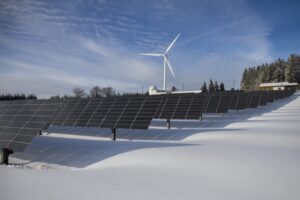The world is in a process of modifying its fossil fuel-based energy matrix to an energy matrix based on renewable energy sources. This will require an enormous process of electrification of all the productive activities of the economy.
However, there are productive and transport sectors that are difficult to electrify. For example, naval and air transport cannot be easily electrified. In addition, the production of aluminum, pig iron, and mining are energy-intensive activities that today use fossil fuels and can hardly be electrified. It is in these sectors that hydrogen can eventually be used as a source of clean energy due to its storage capacity and energy intensity.
Hydrogen is the most abundant element in the universe but not in its pure form, so from the electrolysis of water with sustainable energy sources or the use of fossil fuels, it is possible to obtain this new energy source. This is because one of the most promising outputs in the field of clean energy production is the use of hydrogen to manufacture power cells that do not emit greenhouse gases.
It’s the newest future of the contemporary energy market, since experts say that until 2050 the hydrogen energy production is able to meet 24% of the world demand and help to reduce the emission of CO2 worldwide to zero.

What are Green Hydrogen and Blue Hydrogen
Hydrogen is an element that we do not find free in its isolated form in the universe, but water (H2O) can go through the separation process of molecules and result in 2 hydrogen.
The electrolysis process works as follows: an electric current is bound to electrolysers that separate hydrogen molecules (2H2) and oxygen (O2), at the negative and positive poles respectively.
It is possible to make the electrolysis from sustainable energies, such as wind and solar, which results in the so-called Green Hydrogen (H2G). But this process requires a lot of energy, even more in large scale.
The easiest way to achieve hydrogen is from fossil fuels, mainly natural gas, resulting in the so-called Blue Hydrogen when there is capture of part of the CO2 production.
This type of product is usually produced by the methane reform process or as a result of the natural gas refinement. But it is considered a “dirty” product because it relies entirely on non-renewable fuels and emits many harmful gases into the atmosphere. However, it is a more important process for the industries, since it is a result of the use of natural gas itself.

Credit: Australian Broadcasting Corporation (ABC)
Why Blue Hydrogen is Not a Sustainable Solution
The Blue Hydrogen, even if obtained more easily, causes greater damage to the environment since it needs non-renewable fuels and the procedure emits high amount of greenhouse gases (carbon and methane).
The current productions of Blue Hydrogen emit 10kg of CO2 for every 1kg of hydrogen. Although some industries use the Carbon, Capture, Use and Storage (CCUS) scheme as a means of reducing damage to the environment, this scheme is not able to collect all the emitted carbon, only about 65% to 90%.
The production cost of Blue Hydrogen is currently 1 kg of hydrogen at a cost of US$1.50 to US$3.50, including US$0.50 to $1 for the CCUS procedure. This makes it cheaper than Green Hydrogen, where 1kg of hydrogen costs between US$3.00 to US$7.00 to be extracted.
Therefore, the current industry has started the processes of energy change and transition from Blue Hydrogen, but in the long term the impacts that production causes to the planet must be rethought for total passage to Green Hydrogen.
Why Green Hydrogen can be a key part of the world’s energy transition
The generation of energy by hydrogen is more efficient than those based on fossil fuels, besides being produced by a much more sustainable means.
In addition, as mentioned above, hydrogen can be used as a source of energy for processes that are difficult to electrify, such as maritime transport, air transport, and energy-intensive productive activities such as mining, aluminum and pig iron production.
This hydrogen energy production can change the geopolitical world and trade relations of energy, since it has a future capable of overcoming the hegemony of Saudi oil and Russian natural gas. Unlike fossil fuels, in which the market and business depend on a “luck” of the location of the basins and the proximity to nations, hydrogen is the most abundant element in the universe and is able to be extracted from much more accessible energies (as wind, which depends on the winds, and solar, which depends only on the incidence of light).
This will allow more countries to diversify domestic production and may gain more international importance. This is the case of Namibia, which suffers from high unemployment and low infrastructure development, but has a project of energy production by H2G for 2026 with the generation of 18 thousand works to the local. This is because the city of Lüderitz is located in a desert near the sea, which allows it to have high solar incidence and strong sea winds for energy production.
In addition, the excess of wind energy production can be used and stored via the H2G production process, which allows countries that already have wind energy installations to enter this new technology.
More than 30 countries already have the project to join the production of Green Hydrogen, which will allow a globalization and creation of a new competitive market of a 100% sustainable energy.
Additionally, in late 2023, French scientists made a remarkable discovery by identifying a vast deposit of hydrogen while conducting research for methane in the Lorraine Basin in northeastern France.
This unexpected discovery was identified as the largest natural reserve of hydrogen ever found, projected to contain approximately 250 million tons of the gas, which would be enough to meet global demand for more than two years.
Given this context, the prospect of a possible “gold rush” arises, with companies and investors exploring opportunities in hydrogen deposits around the world, although challenges such as the lack of a consolidated market could impact the accelerated development of this industry.
Green Hydrogen as a MEGA battery
The hydrogen energy efficiency is so high that it has an energy potential of about three times higher than oil and natural gas.
There are already records of the use of hydrogen as an energy source. Hydrogen oil, for example, is used in industry for petroleum refining, metal treatment, fertilizer production and food processing. The NASA uses hydrogen as a rocket fuel since 1950, one of the first initiatives being the use of hydrogen batteries.
Small hydrogen batteries can be used in mobile phones, computers and military equipment and large batteries can even provide electricity to power networks, can serve as fuel for transporting loads, bring energy to places that have no networks and even function as generators for buildings in case of emergency.
In the United States, until the end of October 2021, they had 166 power Cells in 133 places, generating around 260 megawatts (MW). They have a project to produce 485 MW with 5% hydrogen and 95% natural gas combustion projects to generate even more energy.
Renewable power cells can be very useful for storing the excess energy production that renewable sources produce, especially wind. It converts electricity into hydrogen by water electrolysis, stores hydrogen, and later supplies it to a battery to generate electricity. Even with a great loss of stored energy it still manages to dispatch 30% of the excess energy.
Green Hydrogen Limits as a Sustainable Energy Source
The biggest problem of the use of Green Hydrogen in energy production is the cost of the infrastructure.
Sustainable energies such as solar and wind are still new and, although they have a lower cost in recent years, it is even more expensive than the non-renewable energies that are already on the market for longer.
But, in addition, Green Hydrogen is another of the new sustainable energies, that perhaps when get more investment from governments the cost drops, but it is not the place where it is currently. If the cost is now $3.00 to $7.00, there are forecasts that by 2050 it would fall to $1.00 to $2.00.
What weighs most in the production of energy by H2G are the electrolysers, which are more expensive equipment to be able to produce hydrogen on a large scale, but which with greater investment can be more accessible as well.
Novelties in the market always start with a higher price and high cost, but since there is demand for their use and more nations embark on this investment it is possible to revert the situation to a much easier place to get and then really have a change of scenery.
Which countries can become energy powers in the production of Green Hydrogen and how this would affect the balance of power in the energy world
The incentive to more sustainable energy is already being adopted by oil companies such as Repsol, BP e Shell. In addition, several countries are already considering diversifying national energy production to adopt H2G.
The European Union in 2020 promised to invest 430 billion dollars in Green Hydrogen by 2030. They seek to install 40 gigawatt electrolysers over the next 10 years to achieve their climate-neutral impact goal by 2050.
The government of Joe Biden in the USA also undertook to ensure a low of the cost of producing green hydrogen for an average price equal to conventional hydrogen in a decade.
Australia is one of the countries with the largest project of adhesion to H2G, with at least 5 constructions using their wind and solar energy fields. The largest of the projects is the Asian Renewable Energy Hub, in Western Australia, where the electrolysers would be able to generate 14 GW, with an investment of US$36 billion by 2027-2028. The other projects are still in the early stages but may produce 13.1 GW if approved. Thus, Australia is the great pole of H2G production being called “Saudi Arabia’s Green Hydrogen”.
With the Shell projects, the Netherlands is in the process of creating and building electrolysers with a generation of at least 10 GW, no North2 in the Port of Ems. Its forecasts are 1 GW by 2027 to 4 GW by 2030, for offshore wind power. The objective will be to use this hydrogen to supply the industry in the Netherlands itself and also in Germany.
At the same time, Germany is also in the process of adhering to the H2G, the largest project being the Aquaventus in the North Sea where there will be the construction of a base that will produce 10 GW by 2035, with the support of the private sector for the use of wind in the region. Another smaller project will be in Rostock, on the north coast, led by the local company RWE that will give 1 more GW of sustainable energy.
The largest current hydrogen producer is China, which uses hydrocarbons to generate energy. But in order to enter the field of Green Hydrogen, they have a project in Inner Mongolia (China’s autonomous region) led by the state-owned Beijing Jingneng which will invest $3 billion for a potential of 5 GW by the end of 2022 for solar and wind energy in the north of the country.
The Saudi Arabia, leader in the oil market, does not think to stay out of this new investment and has the project Helios Green Fuels based on the “smart city” of Neom in the Red Sea in Tabuk. With US$5 billion they have the plan to install electrolysers that would generate 4 GW up to 2025 via wind and photovoltaics to produce hydrogen from seawater.
The promise of Latin America is in the Chile and in its production of hydrogen via solar energy. They presented in November 2020 a “National Green Hydrogen Strategy” with two main projects: Hyex, of the Chilean mining company Enaex , with support from the French energy company Engie; and the Highly Innovative Fuels (HIF) of several energy and technology companies. The Hyex will be in northern Chile, using solar energy for 1.6 GW-generating electrolysers, with an initial pilot of 16 MW by 2024, and the objective of Green Hydrogen to be used in mining. The HIF will use wind energy in the region of Magalhães and Chilean Antarctica with an initial generation of 1.25 MW but will reach more than 1 GW.
Even the Chilean Minister of Energy, Juan Carlos Jobet, emphasized the ambition not only to neutralize carbon emissions by 2050, but also to become a central nation and exporter of clean fuel.
And Brazil’s plans for the production of Green Hydrogen…
The Brazil also has at least 3 hub projects being designed in the ports of Pecém in Ceará, Suape in Pernambuco, and Açu in Rio de Janeiro, with support from international companies and focus on exports. The most advanced so far is the Ceará project with support from the Portuguese company EDP of R$42 million in electrolysers. There is also the claim to be the first production of “green iron” in Ceará and Rio de Janeiro, in partnership with White Martins and subsidiary of the Australian mining company Fortescue Metals Group. In Pernambuco there is a partnership of the State and the companies Neoenergia Spanish and Qair French. In total, if the plans are implemented, it will be an investment that will exceed US$20 billion.
The Brazilian plan would be to use the production of Blue Hydrogen, from the reserves of fossil fuels that exists in the country, as a strengthening of the export market to transition to Green Hydrogen and forms of sustainable energy.
These investments will allow other countries to enter as major participants in international energy trade, breaking the market hegemony that Saudi Arabia (and other Middle Eastern countries) have with oil and Russia with its natural gas.
The diversification of the economy can allow more growth to nations that have been on the margins of the market, and still using a completely clean and sustainable energy.
Green Hydrogen can completely change the international energy scenario, and can even be a key factor in the replacement of fossil fuels by renewable energy sources.





















[…] if the country has independence based entirely on energies of this type – such as, for example, green hydrogen – it enjoys greater energy security, which is the initial […]
[…] green hydrogen is the result of the separation of hydrogen from oxygen (called electrolysis process) through […]
[…] In recent years, the LNG market has been expanding and it is expected that the demand for liquefied gas will still increase by 25-30% until 2030. This increase derives from factors such as the expansion of liquefaction and regasification technology and the increase in demand for cleaner energy. […]
[…] Green Hydrogen: is more efficient than fossil fuels because it has the ability to create large batteries that store energy by separating hydrogen from the oxygen in water. It is capable of storing 30% surplus energy, and although it is gas-based, it does not emit any pollutants, only water. […]
[…] of 3,300 km, the pipeline is led by Transmission System Operators (TSOs) committed to boosting the supply of hydrogen to meet the growing European […]
[…] but collective ones and in different areas of society, whether using public transport or adopting clean energy generation […]